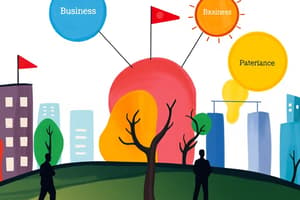Podcast
Questions and Answers
What best defines environmental uncertainty in an organization?
What best defines environmental uncertainty in an organization?
- The overall profitability and financial health of the organization.
- The degree to which an organization is aware of its competitors.
- The frequency of changes in components of the organizational environment and their complexity. (correct)
- The legal regulations governing the industry in which the organization operates.
Which component does NOT belong to the general environment factors that affect organizations?
Which component does NOT belong to the general environment factors that affect organizations?
- Competitive (correct)
- Technological
- Economic
- Socio-cultural
Which of the following factors is included in the economic dimension of the general environment?
Which of the following factors is included in the economic dimension of the general environment?
- Technological innovations and advancements
- Interest rates and inflation (correct)
- Cultural practices and norms
- Government regulations and policies
What aspect does the political and legal environment NOT encompass?
What aspect does the political and legal environment NOT encompass?
What does the term 'demographic factors' refer to in the general environment?
What does the term 'demographic factors' refer to in the general environment?
Which of these elements is part of an international PESTEL analysis?
Which of these elements is part of an international PESTEL analysis?
Which statement is inaccurate regarding the technological environment?
Which statement is inaccurate regarding the technological environment?
Which factor is least likely to affect an organization’s competitive environment?
Which factor is least likely to affect an organization’s competitive environment?
What impact does a strong rivalry among competitors have on industry attractiveness?
What impact does a strong rivalry among competitors have on industry attractiveness?
Which factor does not increase the bargaining power of suppliers?
Which factor does not increase the bargaining power of suppliers?
How is organizational culture primarily transmitted to employees?
How is organizational culture primarily transmitted to employees?
Which of the following is a characteristic of a weak organizational culture?
Which of the following is a characteristic of a weak organizational culture?
In Porter's five forces model, what is the consequence of high barriers to entry?
In Porter's five forces model, what is the consequence of high barriers to entry?
What dimension of organizational culture emphasizes teamwork among employees?
What dimension of organizational culture emphasizes teamwork among employees?
What type of stakeholder has a claim based on ownership of shares?
What type of stakeholder has a claim based on ownership of shares?
Which of the following actions is most likely to reinforce a strong organizational culture?
Which of the following actions is most likely to reinforce a strong organizational culture?
What could indicate a high level of adaptability in an organization’s culture?
What could indicate a high level of adaptability in an organization’s culture?
What is not considered an external stakeholder?
What is not considered an external stakeholder?
Which of the following factors does not lower the threat of substitute products?
Which of the following factors does not lower the threat of substitute products?
What is a common effect of low degrees of differentiation in products?
What is a common effect of low degrees of differentiation in products?
What typically results from a high degree of integrity in an organization’s culture?
What typically results from a high degree of integrity in an organization’s culture?
Which of the following represents an underlying assumption in an organizational culture?
Which of the following represents an underlying assumption in an organizational culture?
Flashcards
Business Environment
Business Environment
Factors outside an organization that can affect its performance, including political, economic, socio-cultural, technological, environmental, and legal forces.
Environmental Uncertainty
Environmental Uncertainty
The degree to which a company's environment is constantly changing and the number of different factors that influence it.
General Environment
General Environment
The broader external forces affecting all organizations, including political, economic, socio-cultural, technological, environmental, and legal factors.
Competitive Environment
Competitive Environment
Signup and view all the flashcards
Economic Forces
Economic Forces
Signup and view all the flashcards
Technological Forces
Technological Forces
Signup and view all the flashcards
Political and Legal Forces
Political and Legal Forces
Signup and view all the flashcards
Socio-cultural Forces
Socio-cultural Forces
Signup and view all the flashcards
Porter's Five Forces Model
Porter's Five Forces Model
Signup and view all the flashcards
Rivalry Among Competitors
Rivalry Among Competitors
Signup and view all the flashcards
Barriers to Entry
Barriers to Entry
Signup and view all the flashcards
Bargaining Power of Suppliers
Bargaining Power of Suppliers
Signup and view all the flashcards
Bargaining Power of Buyers
Bargaining Power of Buyers
Signup and view all the flashcards
Threat of Substitutes
Threat of Substitutes
Signup and view all the flashcards
Organizational Culture
Organizational Culture
Signup and view all the flashcards
Strong Culture
Strong Culture
Signup and view all the flashcards
Weak Culture
Weak Culture
Signup and view all the flashcards
Visible Artifacts
Visible Artifacts
Signup and view all the flashcards
Invisible Culture
Invisible Culture
Signup and view all the flashcards
Stakeholders
Stakeholders
Signup and view all the flashcards
External Stakeholders
External Stakeholders
Signup and view all the flashcards
Internal Stakeholders
Internal Stakeholders
Signup and view all the flashcards
Study Notes
Business Environment
- Environment encompasses external forces that influence organizational performance.
- Environmental uncertainty is the degree of change and complexity in an organization's surroundings.
- Degree of change reflects how frequently components in the environment fluctuate.
- Complexity describes the number of environmental components and the organization's knowledge about them.
General Environment
- Organizations operate within a general environment and a competitive environment.
- The general environment includes broad forces impacting all organizations: political, economic, socio-cultural, technological, environmental, and legal.
- Economic factors include interest rates, inflation, unemployment, and economic growth.
- Technological factors involve infrastructure, advancements, industrial innovations, and changes in production/distribution methods.
- Political and legal factors encompass political stability, government regulations, and legal changes.
- Socio-cultural factors include values, beliefs, traditions, and lifestyles.
- Demographic factors signify population characteristics (age, gender, ethnicity, etc.).
- Environmental factors relate to production methods' environmental impact, sustainable energy, and climate change.
- International factors assess involvement in and effects from global business.
International PESTEL Analysis
- Political factors include government attitudes toward foreign investment, political stability, and intellectual property policies.
- Economic factors involve growth rates, wealth distribution, currency stability, and exchange rates.
- Socio-cultural factors encompass national cultures, attitudes toward foreign companies, and staff.
- Technological factors cover telecommunications, power supply stability, and import/export transport infrastructure.
- Environmental factors consider natural resources, environmental quality, and climate change.
- Legal factors involve tariff policies, trade agreements, employment protection, and company taxation.
Competitive Environment
- The competitive environment comprises forces affecting input acquisition and output disposal.
- Suppliers provide necessary inputs, receiving payment for them.
- Distributors help sell goods/services to customers.
- Customers are individuals or groups buying the product.
- Competitors offer similar goods/services.
Porter’s Five Forces Model
- Porter's Five Forces analyze industry attractiveness.
- Rivalry among competitors is higher with more, balanced competitors and stagnant/declining demand; low differentiation fuels higher rivalry; high exit barriers amplify rivalry.
- Threat of new entrants is lower when there are higher barriers (capital investment, economies of scale, special licenses).
- Supplier bargaining power is higher with fewer suppliers, irregular customer purchases, supplier expansion potential, and high customer switching costs.
- Buyer bargaining power is higher with greater buyer power to negotiate, lowering industry profits.
- Threat of substitutes arises from products in other industries performing similar functions.
Organizational Culture
- Organizational culture comprises shared values, principles, traditions, and work methods.
- Strong cultures offer a close connection between behaviors and values, shared by employees.
- Weak cultures have limited top-management values, where employees don't identify with it.
- Organizational culture arises from founder vision, is communicated through stories, symbols, language, and reinforced by selection and socialization processes; top managers’ actions significantly impact culture.
Levels of Organizational Culture
- Visible artifacts include dress codes, behaviors, symbols, ceremonies, and office layouts.
- Invisible components include shared values and beliefs, observable through stories, language, and symbols, and underlying assumptions guiding behaviors/decisions (role modeling, legends, nicknames, codes).
Dimensions of Organizational Culture
- Adaptability describes the extent of encouragement for innovation, flexibility, risk-taking, and experimentation.
- Attention to detail signifies the expectation of precision, analysis, and focus on details.
- Outcome orientation stresses results over methods.
- People orientation emphasizes the effect on organizational/external people.
- Team orientation encourages collaboration around teams instead of individuals.
- Integrity highlights honesty and ethical principles.
Stakeholders
- Stakeholders are individuals or groups with interests in a company.
- External stakeholders include customers, suppliers, creditors, governments, unions, communities, and the general public.
- Internal stakeholders encompass stockholders, employees, managers, executives, and board members.
- Stockholders seek maximum return on their investments.
- Managers decide on stakeholder-beneficial goals and resource allocation.
- Employees expect rewards based on performance.
- Suppliers expect fair/timely payment.
- Distributors expect quality products at agreed prices.
- Customers are crucial to a company's survival.
- Communities provide operational infrastructure.
Studying That Suits You
Use AI to generate personalized quizzes and flashcards to suit your learning preferences.




